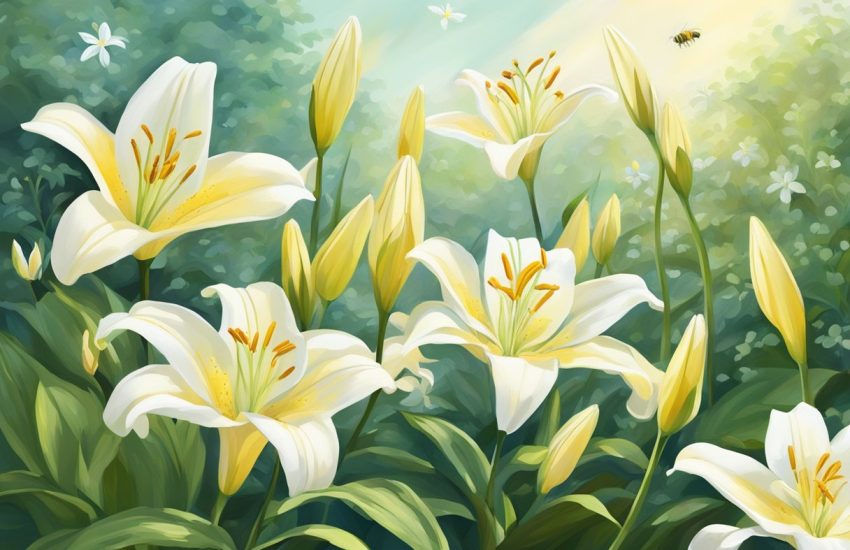Ground Cover Plants Most Suitable to Wisconsin Climate
Ground cover plants are very useful and widely used by landscapers and homeowners in creating a beautiful landscape. Many landscapes have problem areas where cultivating grass is difficult or erosion is a problem. These areas may be too hot, too wet, too shady or too sloped to support adequate growth of grass. Very often the best way to deal with these issues is in using an attractive ground cover to address those particular problem areas. Ground covers are typically perennial plants so it is important to use ones that are rated for the correct USDA climate zone. Since Wisconsin is subject to freezing temperatures during the winter months, any perennial plants should be rated for USDA zones 3 through 5.
Creeping Phlox
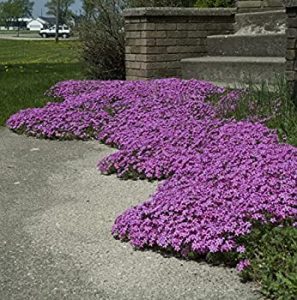
It is one of the most attractive ground covers to be found in spring gardens throughout Wisconsin. The plant forms a colorful carpet in various pastel hues ranging from blue, purple, pink, white and even red. As a relatively carefree ground cover, the plant is useful in rocky or poor soil conditions. Creeping Phlox is often used as a filler between pavers or stepping stones, and is also attractive used to fill in spaces in the spring flower garden. The care of this perennial plant is quite simple as it thrives in well-drained soil in a sunny location. Minimal care and maintenance is required, but an application of fertilizer in early spring will encourage flowering and new growth.
Creeping Phlox should be watered during very hot summer temperatures, especially when planted in full sun on rocky areas. This pretty ground cover easily survives winter in USDA zones 3 through 9, but it is recommended the plants be cut back before cold weather arrives.
Lily of the Valley

This delicate-looking little plant is not often thought of as a ground cover, but it does spread year after year and can be invasive if not controlled. Although not really a lily, the leaves resemble larger lilies and fragrant little white flowers appear in spring. The plant thrives in shade and prefers moist but not wet soil. Unfortunately, this pretty little plant is toxic to pets so homeowners should take this into consideration when determining the planting location.
Snow on the Mountain

Snow on the Mountain is also known as Bishop’s weed, and is a prolific shade loving plant. Attractive green leaves splotched with white form the plants that grow up to 12 inches in height. This pretty ground cover prefers shady areas such as under trees where most plants would fail. Young plants do need to be watered during dry weather, but they can thrive in poor soil so long as it is well-drained. Snow on the Mountain does spread with rhizomes that extend outward from the plant underground and is considered invasive. It is important to contain the plant to the desired area by installing an edging at least three inches below the surface of the soil.
Coral Bells
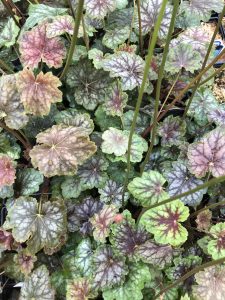
It is not a plant that typically comes to mind when thinking of ground covers, but it works very well in full sun or partial shade. This colorful plant attracts hummingbirds and bees to the garden and prefers well-drained soil that has a highly organic base. Since full or partial sun is it’s preferred location, Coral Bells should be watered well during extended dry spells. Pruning of the spent flower stalks is beneficial to the plant and encourages new growth. This hardy ground cover survives Wisconsin winters well, but sometimes sometimes a hard frost can push it up during a freeze/thaw cycle. When this happens the roots can be exposed and the plant should be tamped back in place or replanted. A generous layer of mulch surrounding the plant over winter is recommended to help prevent this from occurring.
Creeping Thyme
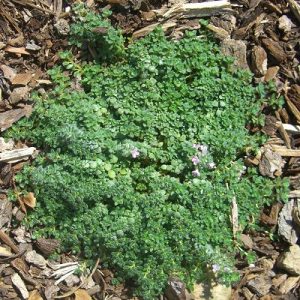
Creeping Thyme thrives in USDA zones 2 through 9 so will easily survive Wisconsin winters. The plant is tolerant to poor soil and grows best in full sun. This hardy little ground cover has few problems so long as it is not located in soil that is too wet, and actually prefers soil that is loose, sandy or even rocky. When temperatures soar Creeping Thyme needs watering more often than the typical 10-day requirement. This ground cover grows up to 6 inches or less and has fine textured blue-green leaves. Creeping Thyme also produce flowers in various shades of pink, purple or white dependent on the type. Thyme plants tend to get woody as they age and should be trimmed back to encourage new growth when that happens. Perhaps the easiest way to cut the plants back is with a lawnmower since the plant has a low growth habit. Creeping Thyme can be sowed directly into the prepared soil in spring, but care should be taken to barely cover the seeds since they need light in order to germinate.
Soapwort
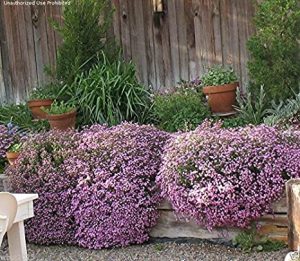
Soapwort is a pretty perennial ground cover also known as Saponaria. As the name indicates, Soapwort has been used in earlier times to make a mild detergent for cleaning and laundry. It is native in certain parts of Europe and was brought by European settlers to North America. The plant grows up to three feet in height and works well in the home flower garden and also as a ground cover. Soapwort thrives in nearly any well-drained soil and prefers fun sun or partial shade. Planting soapwort directly in the garden is simple, but the seeds should not be sown until freezing temperatures are done for the season. Some people prefer to start their seeds in pots to transfer into the garden once the weather has warmed. When setting the plants out they should be planted at least a foot apart or more since they do spread. While Soapwort is quite hardy, it should be watered during the very hot days in summer to keep the soil moist but not soaked.
Soapwort is a spreading plant that seeds itself and will fill empty spaces if left to flower freely. The spread can be controlled by trimming back spent blooms to prevent seed production. The plant is very showy since it produces abundant pink flowers from midsummer well into late fall. Deadheading will encourage more blooms and also prevents the plant from becoming invasive.
Wintercreeper
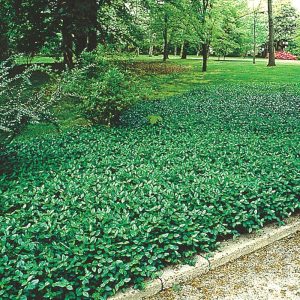
A hardy evergreen ground cover has many uses in the landscape. It also comes in several varieties and colors, so gives the homeowner multiple choices as to how it is used. The plant can be grown as a vine to climb over a gazebo or garden gate, but it is most often used along with larger plants to fill in bare areas. As a ground cover between larger plants, Wintercreeper is useful in cooling the soil temperature and suppressing weeds. Some varieties can pruned into a mound, and does not lose it’s leaves over winter since it is a perennial evergreen. The plant grows best in USDA zones 4 through 9 and will easily survive either cold or mild winters.
Purple Wintercreeper is a variety that is green in summer but the leaves turn a deep purple in winter. Coloratus is similar but the leaves are purple almost all year but become more vibrant in fall. Emerald Gaiety, Emerald N’ Gold and Summer Sun are more colorful types with edges highlighted with cream, gold or yellow splotches. Minimus is a smaller type that is not as fast growing as the rest.
Wintercreeper can be invasive if not controlled, but some gardeners use it to cover their entire lawn instead of grass if their soil is particularly poor. It can be mowed to control the height if desired and looks beautiful growing on a lawn with a lot of trees. The plant originated in Asia and found its way to the United States and Europe late ion the 19th century. It can be considered invasive in certain areas, so homeowners should check their area for restrictions before planting.
Lamium

Lamium is lovely silver and green plant that is also known as Deadnettle. The plant is a semi-evergreen and is in the mint family. Lamium lights up dark areas of the garden with the silvery patterns of lighter green leaves. Pretty lavender flowers adorn the plant from late spring and into early summer. These plants work well in wooded areas or in a shade garden. Lamium should be planted from to 12 to 18 inches apart in moderately rich, moist but well drained soil. A balanced fertilizer applied on a monthly basis will keep the plant healthy, and deadheading regularly will help to keep it blooming.
Bloody Cranesbill
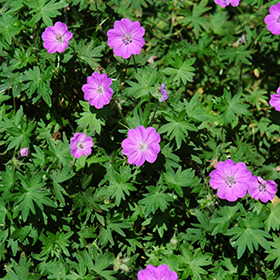
Cranesbill is a hardy variety of geranium. The name is in reference to both the color of the flowers and the seed of the plant that resembles a cranes beak. The plant typically reaches a height between 9 and 12 inches, and it forms a mound as much as 2 feet across. This attractive ground cover blooms from late spring and into the early summer, and the small leaves add interest to the autumn garden as they turn various shades of red in fall. Cranesbill is hardy in USDA zones from 3 to 9, and tolerates extremes of either cold or heat better than other geraniums. They are easy to grow since they only need medium moisture in well draining soil. A light application of organic amendment is recommended in early spring.
Bloody Cranesbill works well along the foundation of a home and adds to the curb appeal with few maintenance requirements. These plants often self-propagate so new plants can be moved to other locations in the landscape if desired. At he end of the growing season the plant should be cut down to the ground as new growth will appear in spring.
Snow-in-Summer
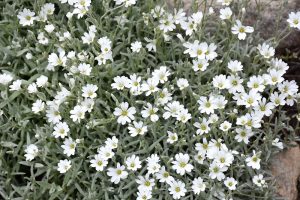
Snow-in-Summer is a perennial plant that is named for its blooming habit. It welcomes early summer with pure white flowers that resemble a recent snowfall. This ground cover is in the carnation family and is also valued for the silvery leaves as well as the lovely flowers. The leaves create a mat of foliage that support the flower stems arising from late spring to early summer. Snow-in-Summer works well as a ground cover for sunny areas that tend to be dry. The plant is used often in rock gardens and to fill spaces around spent spring bulbs.
Crown Vetch
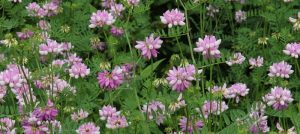
Crown Vetch is a beautiful plant with abundant pink or lavender flowers floating above dense shiny green leaves. Unfortunately, it can no longer be used due to how invasive it is. More than 60 years ago the highway department planted it extensively on the steep banks along public highways, and the plants are still seen throughout the state. Crown Vetch works very well in controlling erosion due to the dense mat the roots form on the soil surface.
Bottom Line
Wisconsin is a state with a considerable variation in climate and seasonal temperatures. Northern areas of the state can be heavily wooded so residents often find they need ground cover plants that grow well in the shade. These shade loving plants also need to be tolerant of cold to survive the freezing temperatures common in northern Wisconsin winters. Central Wisconsin has moderate temperatures ranging from hot weather in summer to snow and cold weather during the winter months. Homeowners in this area may find their landscape needs help in areas that are shady, dry or susceptible to erosion. The southern areas of Wisconsin tend to be warmer, so ground covering plants less tolerant of freezing temperatures can be used there. Wisconsin is a beautiful state and residents will be able to create an attractive landscape wherever their home is located.

